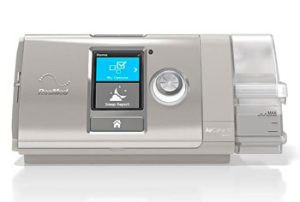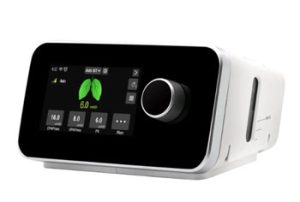Has your doctor recommended you use a BiPAP machine? If so, we are here to help you in the decision-making process.
BiPAP stands for bilevel positive airway pressure. Although BiPAP machines can be used to assist breathing for various medical conditions, they’re often prescribed to patients who have sleep apnea, a disorder that causes problems with breathing while sleeping. BiPAPs deliver two levels of air pressure – one when breathing in and another when breathing out. The air pressure helps keep the airways open while you sleep.
In this article, we’ll cover the top BiPAP machines available, breaking down the important details of each one.
Best BiPAP Machines for 2024
- ResMed AirCurve 10 VAuto BiPAP Machine – Editor’s Pick
- Wellue Auto BiPAP Machine – Best Budget BiPAP Machine
- 3B Medical Luna G3 BiPAP 25A Auto BiPAP Machine – Best BiPAP Machine Features
ResMed AirCurve 10 VAuto BiPAP Machine – Editor’s Pick
ResMed AirCurve 10 VAuto BiPAP Machine
This BiPAP device has three therapy modes and connects to your smartphone, so you can track the feedback it provides.
Sleep Advisor Score
4.40 / 5





Why the ResMed AirCurve 10 Earned Editor’s Pick
This top-of-the-range BiPAP device features an integrated heated humidifier that’s compatible with ResMed’s optional heated tubing, for optimal temperature control and humidification. Three therapy modes, a mask fit feature, automatic leakage compensation, and a handy sleep coaching app are just some of the reasons why the ResMed AirCurve 10 are why this product earned the top spot on our list.
ResMed’s myAir app is especially appealing. It automatically receives data from your AirCurve 10 and provides feedback on your smartphone. If you don’t want to use the app, you can access a basic, user-friendly sleep report on the device’s screen. All data is also stored on a removable SD card.
Our Take: ResMed has poured decades of PAP experience into the AirCurve 10, packing a multitude of advanced features into its sleek, user-friendly design.
What We Liked
- Choice of therapy modes – This BiPAP machine also serves as a CPAP and an auto-adjusting BiPAP device, offering three therapy modes in one. Auto mode adjusts pressure throughout the night, depending on how you’re breathing.
- Automatic leakage compensation – ResMed’s Vsync technology monitors the mask for leaks, which can negatively affect air pressure. When it senses a mask leak, the machine increases pressure, ensuring you receive consistent therapy throughout the night.
- Easy-Breathe™ technology – The device’s Easy-Breathe™ function replicates your natural breathing pattern to deliver air more comfortably during therapy.
- SmartStart and SmartStop – The SmartStart function begins therapy when it detects that you’re breathing into the mask, which avoids the need to have to reach over and start the machine after you’re already snuggled in bed. SmartStop ceases therapy when it detects mask removal.
- Ambient light sensor – Screen brightness automatically adjusts according to light levels in the room, so your partner shouldn’t be disturbed by a sudden bright screen if you need to adjust settings in the middle of the night.
Potential Drawbacks
- Controls can be confusing – It can take some time to get your head around the many settings of this sophisticated machine, so be sure to completely read the instruction manual before using it for the first time to avoid any unnecessary bedtime stress.
- Slightly louder than average – At a maximum noise level of 27 decibels, this device runs slightly louder than many other BiPAP devices, but it’s still only a little louder than a whisper, so this will likely only affect the most sensitive of sleepers.
- High cost – Unsurprisingly, machines with more advanced technology like the ResMed AirCurve 10 don’t come cheap, and this is one of the pricier BiPAP machines available. Check if your insurance will cover this amount, or if it falls within your personal budget.
Wellue Auto BiPAP Machine – Best Budget BiPAP Machine
Wellue Auto BiPAP Machine
The Wellue Auto BiPAP machine is an affordable option with multiple therapy modes.
Sleep Advisor Score
4.90 / 5





Why the Wellue Earned Best Budget BiPAP Machine
Do you need an affordable BiPAP machine with multiple therapy modes, an extra high-pressure range, and an extended ramp time? How about a user-friendly touchscreen, built-in heated humidification, and automatic leakage compensation? These are all qualities you’ll get with the Wellue, our Best Budget choice.
As mentioned, there are multiple therapy modes to choose from on this machine. Along with BiPAP, you can set it to CPAP, S mode, ST mode, Auto ST, T, and PC, giving you even greater control over your therapy. Your healthcare provider will advise you about which modes you should and shouldn’t use.
This BiPAP is modestly priced but packs in a whole host of fantastic features, so you shouldn’t feel like you’re missing out on too much if budget is your main concern.
Our Take: Low price doesn’t always equate to low quality, and that’s certainly the case with the Wellue Auto BiPAP. This machine is full to the brim with features that should make your BiPAP therapy a breeze without breaking the bank.
What We Liked
- Large touch screen – The 5-inch touch screen on this device is super convenient for sussing your settings and accessing sleep data, without having to toggle using a clunky dial.
- Automatic leakage compensation – This machine detects mask leaks and increases air pressure accordingly. This ensures that consistent pressure is delivered, which avoids any interference with your therapy.
- Expiratory relief – Exhalation pressure is usually set at a lower level during BiPAP therapy, but some people may still have difficulty exhaling. This device’s IPR (Intelligent Pressure Relief) technology reduces exhalation pressure when it detects struggles, while still providing enough pressure to keep the upper airway open.
- Extra high-pressure range – The Wellue Auto BiPAP tolerates from 4-30 cm H20, which is 5 cm higher than most other BiPAP machines – ideal for patients who have been prescribed a high therapy setting.
- Longer ramp time – The standard maximum ramp time of most PAP machines is 45 minutes, but the Wellue Auto BiPAP gives you up to one hour before the full pressure level kicks in, allowing you to set it in 5-minute increments. This could be a bonus for people who struggle to fall asleep during PAP therapy.
Potential Drawbacks
- No sleep data app – Up to three years’ worth of sleep data is stored on the device’s SD card, which can be viewed on the device screen, a Windows computer, or an online data management tool. However, unlike some other devices, there’s no app available to keep track of your data remotely on your phone, which may be a drawback.
- Optional mask may be uncomfortable – A number of online reviews complain of discomfort when using the mask that can be purchased with this machine, so it may be worth spending some extra time shopping around when deciding on a mask.
3B Medical Luna G3 BiPAP 25A Machine – Best BiPAP Machine Features
3B Medical Luna G3 BiPAP 25A Machine
This BiPAP device has RESlex technology to create a more natural breathing experience.
Sleep Advisor Score
5.00 / 5





Why the 3B Medical Luna Earned Best BiPAP Machine Features
This device packs a punch when it comes to BiPAP therapy, with a 360ml capacity heated humidification tank and heated tubing included as standard. With a pressure range of 4-25 cm H20, and the ability to function as a CPAP and auto-BiPAP, as well as regular BiPAP, it should be suitable for a wide range of positive airway pressure (PAP) users.
RESlex technology allows the machine to reduce pressure on the exhale within a set range, adapting it on a breath-by-breath basis when it detects you’re having issues exhaling. This helps to create a more natural breathing experience, which could make therapy more comfortable.
We also appreciate this product’s sleek design. With smaller-than-average dimensions, this device will be less cumbersome on your bedside table.
Our Take: The 3B Medical Luna G3 BiPAP includes nifty features you didn’t even know you needed, like supply reminders, a preheat function, and exhalation relief technology.
What We Liked
- Preheat feature – When using heated humidification, you can make use of the preheat function, which may be used up to 30 minutes in advance. This ensures the machine is ready to use by the time you hop into bed.
- Auto-start/stop function – Instead of having to reach over and turn the machine on after getting comfy, the 3B Medical Luna will only start delivering pressure when it detects you breathing into the mask and will stop when you take the mask off.
- Low noise – Operating at a maximum sound level of 26 decibels – the sound of a whisper – the multi-stage noise reduction technology on this device should leave you sleeping undisturbed.
- Supply reminders – PAP accessories need replacing regularly, so forgetful types might love the ability to set reminders on this machine, which notify you when you need to change your mask, tube, or filter.
- Heated tubing – Heated tubing comes as standard with this machine, which helps prevent rainout. This occurs when heated air cools down in the hose, leading to condensation in the mask.
Potential Drawbacks
- No leakage compensation – The machine has an audible leak detection feature, which sounds an alarm to wake you up if it detects that your mask is leaking, so you can adjust it. While this is a useful feature, some people may prefer a machine that automatically increases pressure to compensate for mask leaks, which can avoid any nighttime awakenings.
- QR code app – To see your sleep data on the 3B Luna QR app, you have to individually upload each night’s data using a QR code, which is less convenient than some other models that upload this information automatically.
- Not touchscreen – This device doesn’t feature a touch screen; instead, you navigate the menu using a dial, which isn’t as user-friendly. While this may not be a dealbreaker, it’s something to consider when you’ll be using the machine every day.
What Is a BiPAP Machine?
A BiPAP machine is a medical device that’s prescribed to people with certain medical conditions to help them breathe more normally. It’s commonly used to treat sleep-related breathing disorders like sleep apnea and is worn while sleeping, either at home or in a medical setting. BiPAP stands for bilevel positive airway pressure, which means that air is delivered at two set pressure levels; a higher pressure for the inhale, and a lower pressure for the exhale1, allowing the user to breathe out more comfortably.
What to Look for in BiPAP Machine
Features
Most modern BiPAP machines have integrated humidification, which can be heated or non-heated, or they have the option of attaching an external humidifier. The lungs function best with warm, moist air2, and a humidifier can facilitate this, making for a more comfortable BiPAP experience.
Some machines also allow the use of heated tubing, which can further aid humidification, as well as prevent rainout. Rainout occurs when warm air enters a cold tube, causing condensation, which can lead to a damp face and mask.
Other features to consider include therapy feedback apps, mask leakage compensation, the choice of multiple therapy modes, and an auto start/stop function.
Doctor’s Recommendation
While there are fewer choices of BiPAP machines available than CPAP machines, it can still be overwhelming trying to find the one that’s right for you. With a wealth of experience behind them, your healthcare provider should be your first port of call when seeking recommendations, as they’ll be able to tell you which type of machine would best suit your individual needs.
Pressure Range
Your prescription will determine the pressure level you require to resolve apnea, so first and foremost, you should ensure the machine you choose accommodates this. Most BiPAP machines offer a pressure range between 4 to 25 cm H20, though some go higher.
Ramp Options
Ramp mode is useful if you find it difficult to fall asleep while using BiPAP therapy. A timed ramp function will start therapy at a lower pressure level, gradually increasing the pressure over a set period of time (usually up to 45 minutes), which gives you a chance to fall asleep before maximum pressure is delivered. Some machines have an auto ramp feature, which increases pressure once it’s sensed you’ve fallen asleep.
Care
BiPAP machines containing humidifier tanks require a little more care than those without, as water should be emptied every morning3 to prevent bacteria or mineral buildup, which can damage the machine. Refill the tank with distilled water each night, and be sure to clean the tank weekly, with warm, soapy water.3
Budget
BiPAP machines tend to cost more than CPAP devices due to their more advanced features, but it’s still possible to find a good quality machine at a lower price point. When shopping on a budget, consider which features are medically necessary, and which non-essential functions you may/may not be prepared to pay more for. You should also discuss BiPAP costs with your insurance provider to see what they might cover.
Warranty
A warranty will ensure that your device is repaired or replaced if it malfunctions due to a manufacturing defect. The average warranty period of a BiPAP machine is two years.
BiPAP Accessories
- Masks – There are different types of masks to suit different face shapes and therapy needs, including full face, nasal mask, and nasal pillow. There’s also a hybrid mask, which is a cross between a full face and a nasal pillow. Costs vary depending on design, but they tend to range from around $45 to $185.
- Hosing – Hosing is what connects the machine to the mask, and it can be heated or non-heated, depending on your needs. Basic tubing can cost as little as $5, while heated tubing can cost more than $50.
- Headgear – Headgear is the strapping that keeps the mask attached to your face, and the design is dependent on the mask style. This usually costs between $20 and $45.
- External Battery – if you are traveling with your BiPAP or are concerned about power outages, an external battery can offer peace of mind, allowing you to use your BiPAP when there’s no other power supply. These tend to cost around $400 and can power your BiPAP device for 8 to 16 hours.
- Humidifier – Humidifiers add moisture to the air delivered by your BiPAP, which can reduce the risk of a dry nose or mouth; two common complaints from PAP users4. Machines vary, but government guidelines5 advise replacing the humidifier chamber every six months. The average cost of a replacement internal humidifier is about $25.
- Filters – Filters eliminate contaminants from the air that are drawn in by the BiPAP machine, and these are either disposable or reusable6. Disposable filters tend to cost between $1 and $10, while reusable ones can range from $5 to $20.
BiPAP vs. CPAP
BiPAP and CPAP machines may look similar, but they deliver respiratory therapy in different ways.
Both machines utilize a motorized unit, tubing, and mask system to help keep the upper airways open. While BiPAP delivers air at two different pressure levels – a higher level for the inhale, and a lower level for the exhale – CPAP, which stands for continuous positive airway pressure, delivers one steady stream of pressurized air.
CPAP is generally the first line of defense for patients with obstructive sleep apnea7. Doctors may advise a switch to BiPAP for people who struggle to breathe out against the fixed air pressure of a CPAP8, and BiPAP may be more suitable for those who have central sleep apnea9, which is where the brain fails to send the right signals to the muscles that control breathing. BiPAP therapy can also be used in the treatment of complex sleep apnea10, which is a mix of both obstructive and central sleep apnea.
BiPAP machines are also used to assist with breathing in intensive care situations, as well as in patients with chronic obstructive pulmonary disease (COPD), heart failure, and hypercapnic respiratory failure.1
Frequently Asked Questions
What are the disadvantages of using a BiPAP machine?
As with all PAP machines, using a BiPAP machine does carry the risk of side effects11, such as skin irritation, sinus congestion, bloating, dry mouth, and eye irritation caused by mask leaks. However, many of these can be eliminated by ensuring you have the correct size/style of mask, making sure the mask is fitted properly, and utilizing the machine’s humidification feature. Always seek advice from your doctor or equipment provider if you’re experiencing uncomfortable side effects.
Can you ever stop using a BiPAP machine?
This will depend on why you’re using the device. In the case of sleep apnea, PAP therapy does not cure the disorder2; rather, it only relieves the symptoms, so it must be used consistently and as directed to ensure effective therapy. Left untreated, sleep apnea can lead to more dangerous health complications, such as heart failure and arrhythmia.7
However, in cases where BiPAP is being used to treat breathing failure caused by other illnesses, therapy may be stopped once the patient can breathe normally unassisted.11
How many hours a day should you use a BiPAP machine?
This depends on your individual diagnosis and reason for using a BiPAP. When used in the treatment of sleep apnea, studies13 show that medical benefits start after using PAP for two to three hours per night. These benefits increase each hour, up to seven hours, so for the best results, you’ll likely be advised to use your BiPAP machine all night, every night.

Lisa Bowman
Writer
About Author
Lisa is a content writer for Sleep Advisor, which combines two of her greatest passions – writing and sleeping. She can also be found writing about fitness, sustainability and vegan food.
Combination Sleeper
- 1. “BiPAP”. Cleveland Clinic. Last modified May 10, 2024. –
- 2. “Mouth Breathing”. Cleveland Clinic. Last modified April 11, 2022. –
- 3. “Keeping Your CPAP Clean”. UCDH Sleep Disorders Center. Webpage accessed November 1, 2024. –
- 4. Bortolotti MD, Mauro. “The Cause of Dry Mouth During CPAP Application”. Journal of Clinical Sleep Medicine. 2017. –
- 5. “Replacement Schedules for Medicare Continuous Positive Airway Pressure Supplies”. Department of Health and Human Services. 2013. –
- 6. “CPAP Equipment Cleaning and Disinfecting Instructions”. Weill Cornell. Webpage accessed December 18, 2024. –
- 7. “Sleep Apnea”. Cleveland Clinic. Last modified November 15, 2022. –
- 8. Girouard, Ayla. “CPAP vs. BiPAP vs. APAP: What’s the Difference?”. National Council on Aging. 2024. –
- 9. “Central Sleep Apnea”. Mayo Clinic. Last modified July 11, 2024. –
- 10. Palman, A. “Complex Sleep Apnea”. Neuroscience and Behavioural Physiology. 2018. –
- 11. “BiPAP”. Johns Hopkins Medicine. Webpage accessed December 18, 2024. –
- 12. Malhotra MD, Atul. “Obstructive sleep apnea: Overview of management in adults”. UpToDate. 2024. –
- 13. Malhotra, A., et al. “Dose Response Relationship Between Positive Airway Pressure Adherence and Clinically Important Outcomes in Patients with Obstructive Sleep Apnea”. American Journal of Respiratory and Critical Care Medicine. 2022. –



